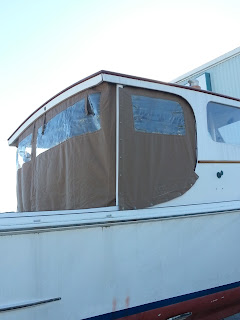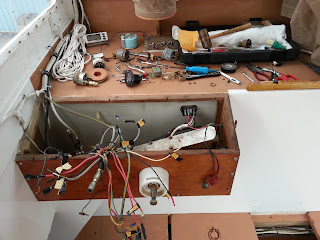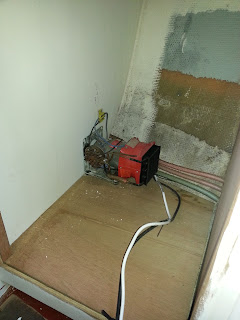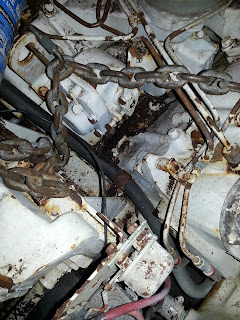The bilge inside the cabin is connected to the main bilge under the engine so of course it too needed some love.
Since we had some nice weather for a couple of days in late January I also took a chance to pull out the canvas and see how it fits to the pilothouse.
It looked pretty good except for the places where work had been done to the wood on the pilothouse and no one got around to replacing the fasteners in the wood. I guess that they never used it once it had been made?
But it will be easy for me to install those little fittings at little cost. I was just glad that the canvas and the isinglass was in excellent shape, very little use.
Next up was the instrument panel.
I will be reconditioning/replacing as needed. It is nice that the transmission has a pressure gauge but not as nice that it functions mechanically instead of electrically. It uses a long length of hose containing 200 - 400 psi of oil tapped directly from the gearbox; not so fun if that long skinny hose springs a leak. It will be replaced with an electric pressure sensor mounted to the gear case and a single wire to feed a signal to the sensor on the panel. Total cost about $60 for a bit more peace of mind. The big surprise was that none of the instruments had lights! I guess the previous owners just did not navigate at night? Anyway, another easy fix, a couple of bucks for each light fittings and some extra wire.
And now for my first tool casualty.
I was using this small ball peen hammer to pry up a floor panel that was swollen shut. Oops. Too bad, I have had that hammer for 30 years. But it may have been worth it. See the photo below of yet more bilge gunk.
I gave it a quick scoop out and wipe down and will wait for warmer weather to do a more thorough cleaning.
Oh. and one more thing. I discovered some more info to add to the story. The Chinese year of the dragon has more than one type of dragon, some years it is a fire dragon, some years an earth dragon or an air dragon, but 2012, the year that I pursued and purchased Dragon Lady is a WATER dragon. Additionally, she was built during a water dragon year and I was born during a water dragon year. Too groovy/celestial/whatever.
Cheers.
And now for my first tool casualty.
I was using this small ball peen hammer to pry up a floor panel that was swollen shut. Oops. Too bad, I have had that hammer for 30 years. But it may have been worth it. See the photo below of yet more bilge gunk.
I gave it a quick scoop out and wipe down and will wait for warmer weather to do a more thorough cleaning.
Oh. and one more thing. I discovered some more info to add to the story. The Chinese year of the dragon has more than one type of dragon, some years it is a fire dragon, some years an earth dragon or an air dragon, but 2012, the year that I pursued and purchased Dragon Lady is a WATER dragon. Additionally, she was built during a water dragon year and I was born during a water dragon year. Too groovy/celestial/whatever.
Cheers.























